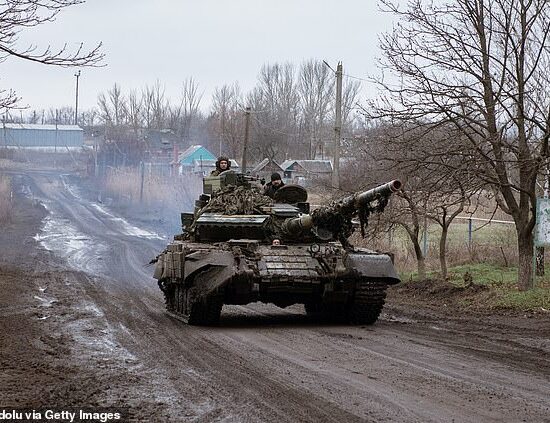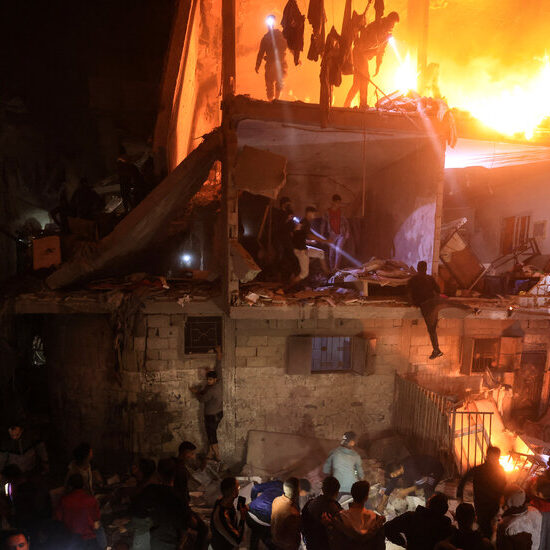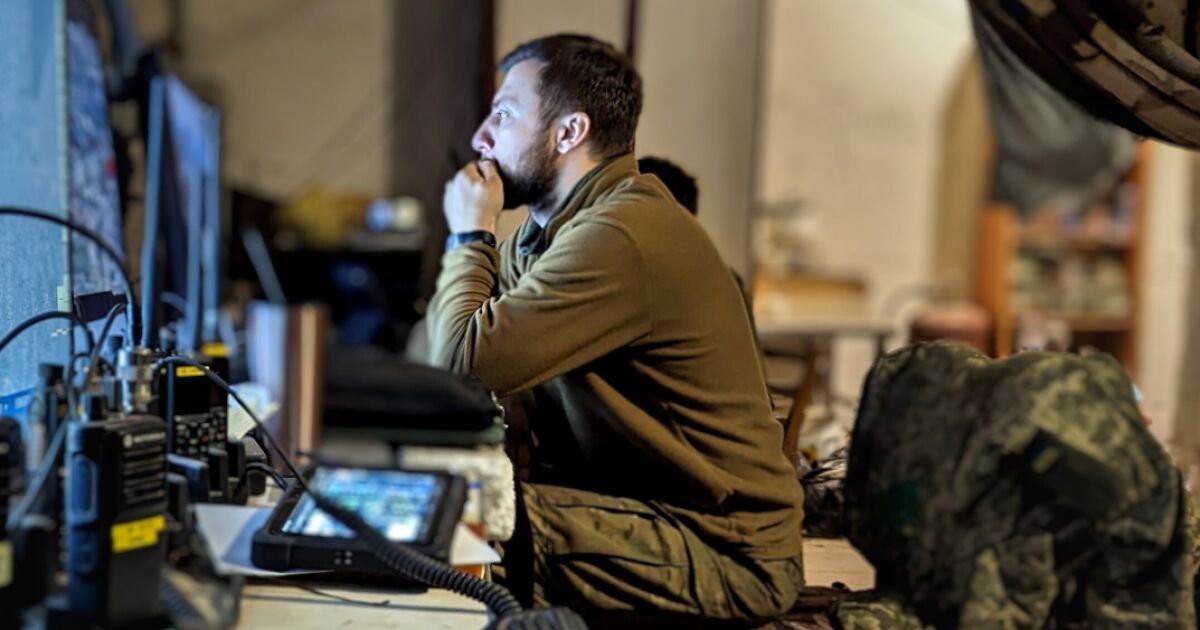
The Russian infantrymen slinked back and forth in twos and threes to a house in one of this embattled city’s devastated neighborhoods, ferrying ammunition, an automatic grenade launcher and a heavy machine gun ahead of a planned attack.
Hidden in a high-rise, a pair of Ukrainian soldiers watched it all on a feed from the consumer drone they were piloting.
One of the pilots, whose military nickname is Liova, trained the camera on a pair of soldiers next to the house.
“I see two … moving,” said the other pilot, who calls himself Tezka, speaking into a chat server.
In a basement a few miles from the house, commanders from the 251st Battalion studied the drone feed. They barely seemed to notice the steady beat of incoming fire or the bup-bup-bup of a barrage of rockets — even when one landed close enough to shake the floor.
The battalion’s mortar commander, who goes by the name Zeus, called up the GPS coordinates of the house on a tablet, pressed a drop-down menu to select a weapon and ordnance type and put the information into a ballistic calculator. Switching between his smartphone and an encrypted radio, he instructed soldiers at another location to dial in their 82-millimeter mortar.
A Ukrainian battalion’s mortar commander, who goes by the name Zeus, communicates coordinates and adjustments to his team.
(Nabih Bulos / Los Angeles Times)
“Time to target, 32 seconds,” one responded. The drone watched overhead: The first shot went wide.
Zeus stared at the screen. This time he ignored the ballistic calculator and eyeballed the adjustment.
A direct hit.
The long fight for Bakhmut has been block-by-block, house-by-house savagery grinding up men, materiel and masonry. But backing it is a parallel sort of combat, one that juxtaposes 19th and early 20th century weapons such as artillery and mortars with 21st century consumer tech — drones, messaging apps, teleconferencing services, satellite internet terminals, cloud-synced mapping software.
An hour after the attack on the house, the Russians were in retreat. Another round took out their cache of explosives. Through the drone, Tezka saw one soldier wounded, another tending to him, while three more brought a stretcher.

Smoke rises from burning buildings in March in Bakhmut, the scene of heavy battles in the Donetsk region of eastern Ukraine.
(Libkos via Associated Press)
Zeus spoke into an encrypted radio. The mortar fired again, and the soldiers disappeared in a puff of smoke.
The men in the command center cheered as they watched the carnage unfold. One soldier lost his helmet as he crawled and then limped. Another staggered away. A third blast bloomed near them as they escaped, leaving behind at least four dead and one wounded.
On Thursday, Russia’s Defense Ministry announced that its forces had encircled Bakhmut. Earlier in the week, Yevgeny Prigozhin, the Russian oligarch whose mercenary group Wagner spearheads the campaign on the city, said his fighters controlled 80% of Bakhmut. Ukrainian officials denied both claims but did not specify how much of the city remains under their control.
Outnumbered and outgunned, Ukrainian forces have mounted a fierce defense by utilizing tools both primitive and new.
They have achieved some success. In a batch of classified documents leaked to social media in recent days, a U.S. government assessment characterized Russia’s advances in Bakhmut during the second half of last year as “sluggish,” with its forces advancing an average of just 1.7 miles each month. The Times could not verify the authenticity of the document.
Still another document, based on the state of the battle on Feb. 25, quoted a Ukrainian military commander saying his forces had only one path to resupply. In recent weeks, the front appears to have stabilized, even as Ukrainian forces prepare for the worst. Three miles outside Bakhmut, near the village of Kalinina, they were digging trenches for a new defensive line in case they had to pull out.
Helping keep Ukraine in the fight is its aerial surveillance, which relies mostly on quadcopter drones made by the Chinese company DJI, including models available for under $1,500 at Walmart or Amazon.
Far from just flying drones, the 18 pilots who make up the battalion’s air reconnaissance team also assist other units navigate the city and evacuate the injured. More than two-thirds of the team has been wounded in action.
The pilot’s day begins before dawn with breakfast from whatever supplies the brigade can smuggle in. A chunk of moldy bread. Some salo pig fat or oatmeal.
Under a faint lightbulb in the basement, they pack the drones, 20 batteries, cable and antenna, a Starlink terminal and enough food to last their 12-hour shift. They don bulletproof vests and carry their assault rifles, then step out for their stealth run to one of their positions, which must be above ground to maintain signal.
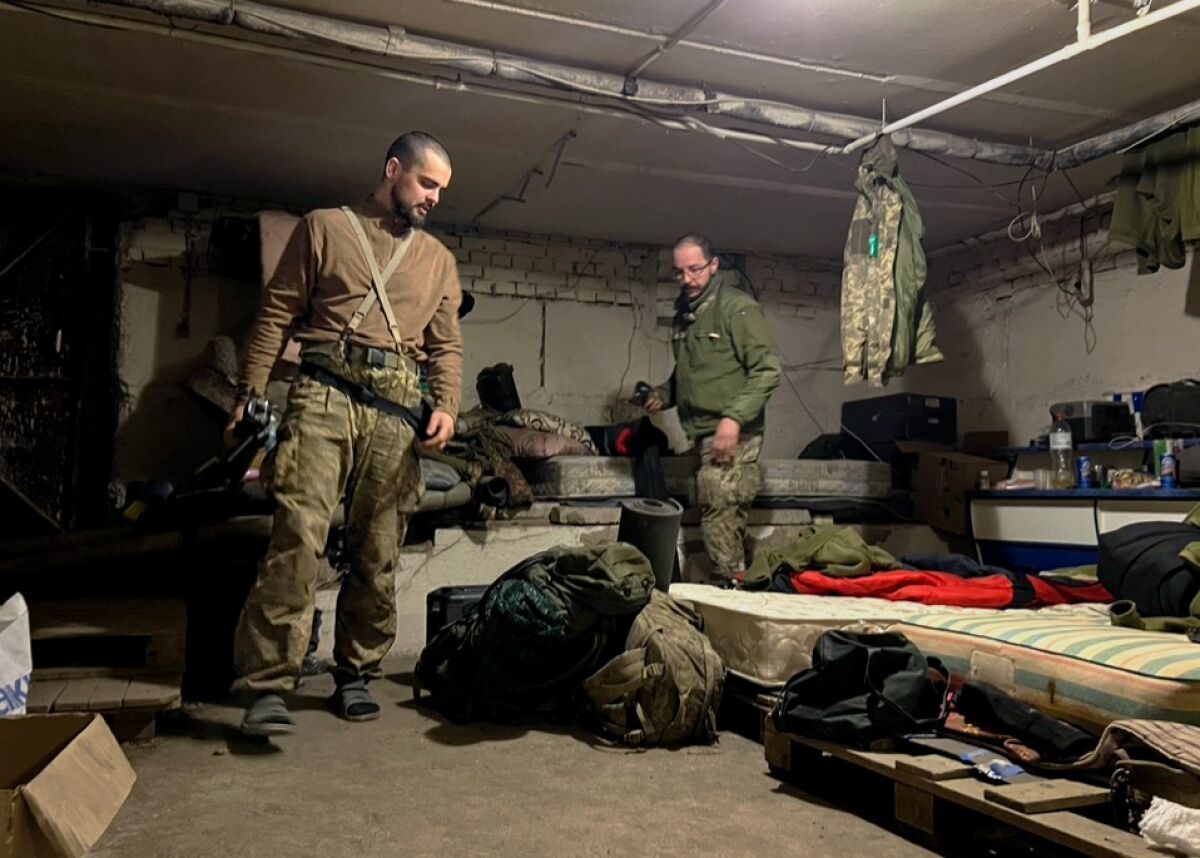
Ukrainian drone pilots known as Liova and Tezka prepare their equipment in Bakhmut.
(Nabih Bulos / Los Angeles Times)
“You feel exposed, every minute, every day, every morning,” said Tezka, who is 36 with an earring and a professorial mien. He worked in IT and built drones before the war.
Once in position, the pilots rotate the drones in and out of air while they change the batteries. They have to collect them quickly: The shelling is ceaseless, and some of Bakhmut’s few remaining residents have stolen the drones when they land.
Drones have also been shot down. But a bigger danger is the Russian army’s electronic warfare abilities, which dwarf Ukraine’s. In other parts of the country, pilots have jury-rigged drones to drop munitions on their enemies. But because Bakhmut’s area is small and Russian jamming powerful and constant, the drone wouldn’t get a chance to get close enough.
On the other hand, that can also be an advantage, said a 30-year-old pilot who goes by the name Makarena and worked in copyrighting before the war. “We’re camouflaged because there’s so much signal interference it’s hard for them to identify the direction we’re flying from,” he said.
Tezka was tinkering with so-called kamikaze drones that fly into their target and detonate, like the Iranian drones Russia has deployed to devastating effect in Ukraine. One evening, he took out a small quadcopter he was working on. It could fly more than 40 mph with a brick of plastic explosive attached to its belly, but he still needed to perfect the detonator mechanism.
Like others in the battalion, Tezka was part of the Territorial Defense Forces, a civilian volunteer force originally employed to man checkpoints and defend local areas. That changed in June when military commanders expanded the force’s remit to bolster army troops.
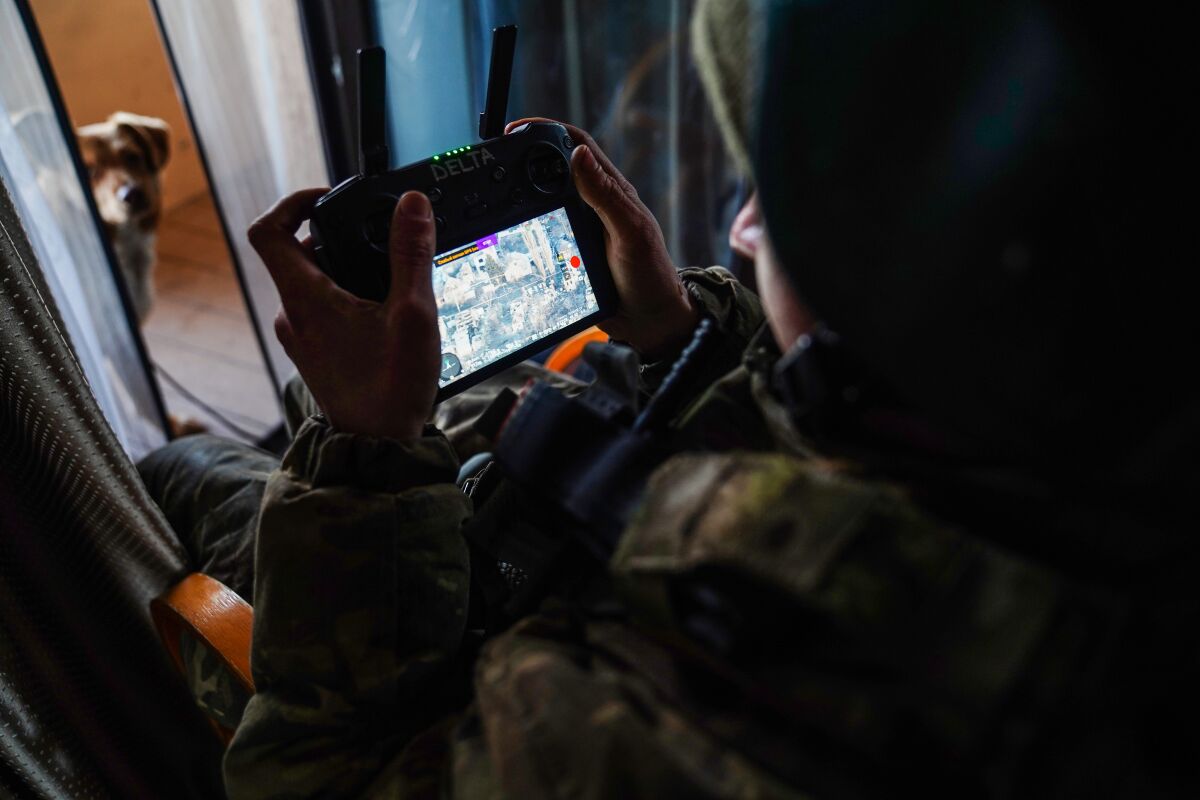
A member of the Ukrainian aerial reconnaissance monitors the situation in Bakhmut in February.
(Taras Ibragimov / Global Images Ukraine via Getty Images)
Tezka and the rest of the 251st were deployed to Bakhmut more than a month ago, supporting other units — including other drone pilots — in an increasingly desperate defense. That they were now fighting in the war’s longest and bloodiest campaign reflected the government’s strategy: Saving its top troops — trained and equipped by Western allies — for a do-or-die counteroffensive expected to begin soon, while throwing whatever it had left to prevent a Russian advance.
But in the meantime the 251st was tired, the tension of being constantly hunted by the Russians’ barrage wearing on them.
“What was my worst moment in this war?” said Liova, 29, whose wife is due to give birth to a daughter in May. “Every morning, because the circle around us is closing.”
Exacerbating their exhaustion was frustration with continuous ammunition shortages. To avoid wasting ammo, targets had to be big enough and suspected enemy positions confirmed by multiple sources to warrant launching attacks.
Makarena remembered a time he watched a Ukrainian squad get cut down by a heavy machine gun emplacement he had detected but was never attacked because it hadn’t been confirmed.
The drone-and-mortar warfare plays out not just within the urban hellscape of Bakhmut, but also in the bucolic east Ukrainian towns and villages on its flanks, mostly abandoned and ruined, where Russian troops and mercenaries push for control of entrances into the city.
Off a country road some seven miles away, a crew oriented a French mortar in the direction of Russian troops battling to capture one of the main highways into the city.
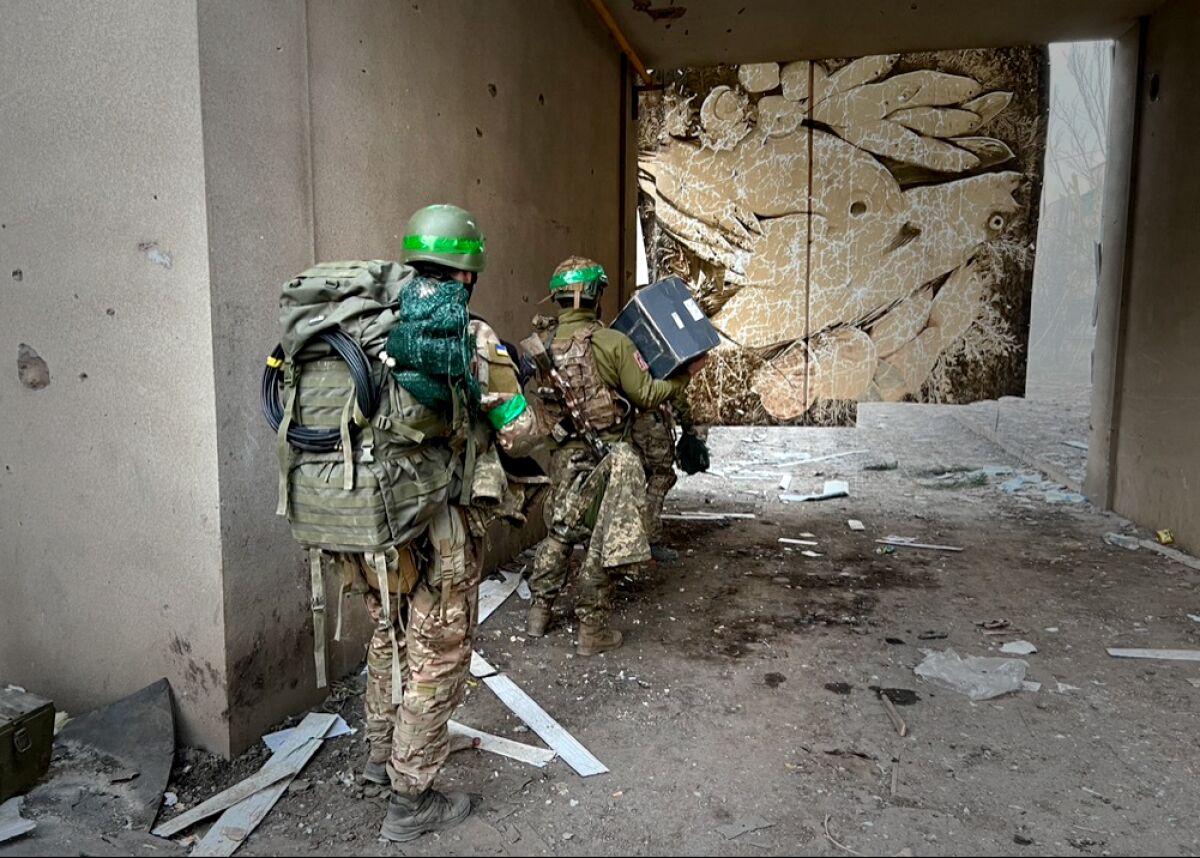
Members of Ukraine’s 251st Battalion air reconnaissance unit en route to their position in Bakhmut.
(Nabih Bulos / Los Angeles Times)
“They’re doing everything to seize control,” said Sensei, a 42-year-old commander in the 3rd Mortar Brigade. The crew let loose one round, then after consulting a drone operator, adjusted aim and shot again. The men moved quickly back into hiding to avoid detection.
The fight continues at night. Back at the 251st’s command center, a commander named Volodymyr remained fixated on the drone feed, his eyes red from hours of watching. On a thermal image of Bakhmut, one spot glowed brighter than the others — the site of an earlier artillery attack. Just before midnight, after almost 18 hours on station, he finally turned away and walked the few steps to a line of mattresses arrayed against the wall to lie down.
Barely six hours later, Liova, Tezka and Makarena picked up their backpacks. Keeping 15 feet between one another in case of shelling, they emerged from the basement and scanned the corner for enemies, assault rifles at the ready.
They sprinted across the street, turned down a street, and disappeared into the chaos of the blighted city.









